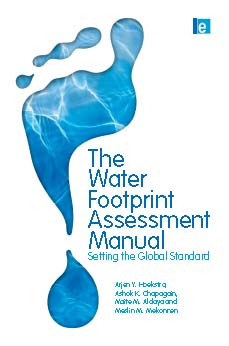 This book by Earthscan contains the global standard for ‘water footprint assessment’ as developed and maintained by the Water Footprint Network (WFN). It shows how water footprints are calculated for individual processes and products, as well as for consumers, nations and businesses. It also includes methods for water footprint sustainability assessment and a library of water footprint response options.
This book by Earthscan contains the global standard for ‘water footprint assessment’ as developed and maintained by the Water Footprint Network (WFN). It shows how water footprints are calculated for individual processes and products, as well as for consumers, nations and businesses. It also includes methods for water footprint sustainability assessment and a library of water footprint response options.
A shared standard on definitions and calculation methods is crucial given the rapidly growing interest in companies and governments to use water footprint accounts as a basis for formulating sustainable water strategies and policies. The current manual is an updated, revised and expanded version of Water Footprint Manual: State of the Art 2009, published by the WFN in November 2009 (Hoekstra et al, 2009a). This new edition has been produced after intensive consultations with partners and researchers worldwide. Directly following the publication of the Water Footprint Manual, all partners of the WFN were invited to provide feedback on the manual.
In addition, two working groups were formed, consisting of individuals from partners of the WFN and invited experts. One working group addressed questions around the grey water footprint while the other one studied issues pertaining to water footprint sustainability assessment. In addition, a number of partners initiated pilot projects in collaboration with the WFN that aimed at exploring the practical implications of using the water footprint in formulating a corporate water strategy or water policy in a specific geographical setting.
The manual deals with the four distinct phases of full water footprint assessment –
- Setting goals and scope.
- Water footprint accounting.
- Water footprint sustainability assessment.
- Water footprint response formulation.
The manual is structured as follows –
- Chapter 1 provides an introduction while abovementioned four phases of water footprint assessment are addressed in the following chapters.
- Chapter 2 shows the important issues that have to be considered when setting the goals and scope in water footprint assessment.
- Chapter 3 contains the definitions and methods for water footprint accounting.
- Chapter 4 gives guidelines for the stage of water footprint sustainability assessment.
- Chapter 5 gives an overview of water footprint response options to be considered in the stage of policy formulation.
- Chapter 6 puts the method of water footprint assessment in a wider context and discusses its limitations.
- Chapter 7 identifies and discusses the major challenges to be addressed in the future.
- Chapter 8 is the concluding chapter.
The basics of water footprint accounting – process and product accounts are relevant for all water footprint applications. In the course of the text, various concepts will be defined. In order to make it easy for the reader to look up the definitions of key terms used in this manual, a glossary is included in the back of the book. Another helpful section in the book is Appendix VI, which addresses the most frequently asked questions in the context of water footprint assessment.